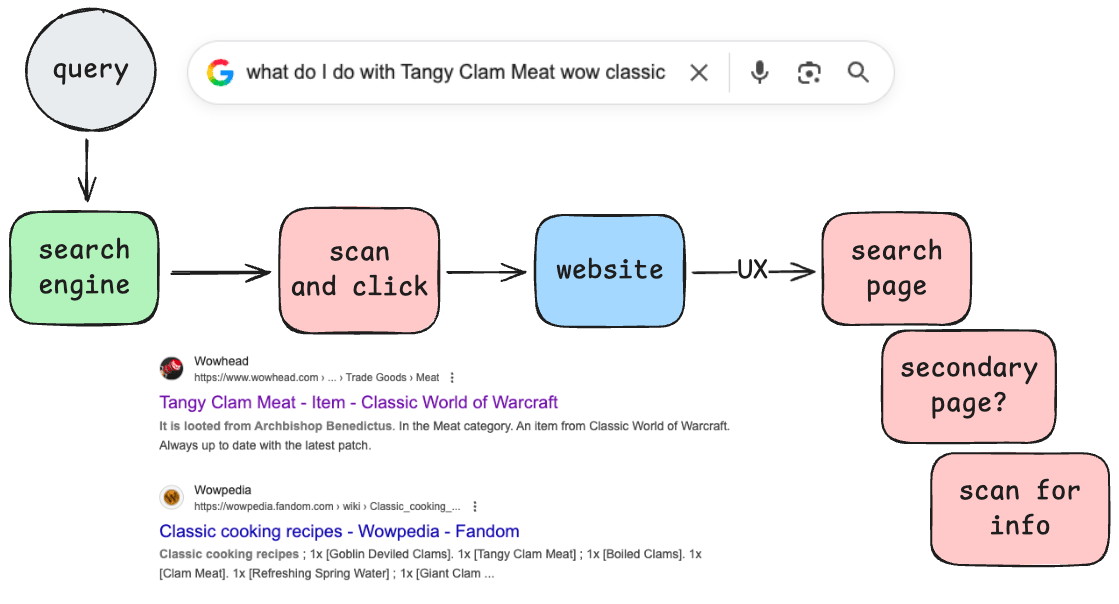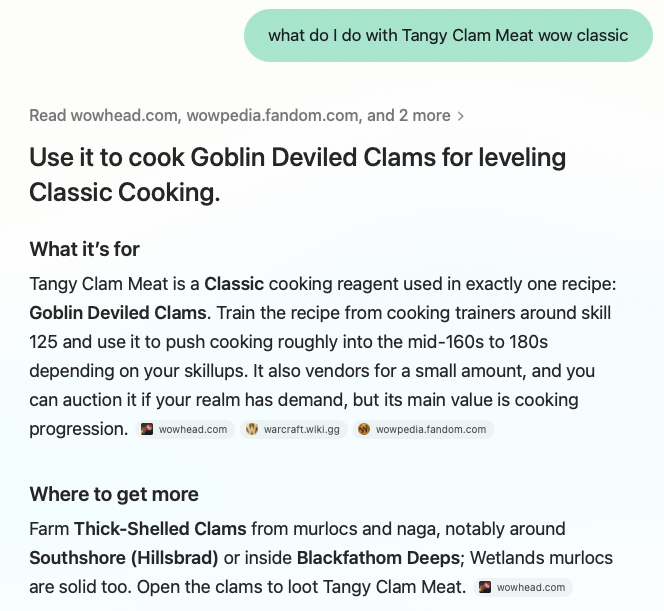The Death of Clicks
How AI Search is Rewiring the Internet Economy
I was deep in a World of Warcraft inventory crisis the other day—bags full of random items with cryptic names. “Tangy Clam Meat” sat there taunting me. What do I even use this for?
This simple gaming question sent me down two very different paths that perfectly illustrate how search has fundamentally changed. And if you’re running any kind of online business or content operation, this shift is about to upend everything you know about visibility, traffic, and revenue.
A Tale of Two Searches
Path 1: The Traditional Google Journey
When I typed “what do I do with Tangy Clam Meat wow classic” into Google, I entered a familiar but exhausting maze:
Step 1: Google shows me search results (after scrolling past AI summaries I don’t trust yet)
Step 2: I click on WowHead because it ranks first
Step 3: I’m bombarded with ads—top, bottom, sides, pop-ups
Step 4: I navigate their specific UI, hunting for information
Step 5: I discover I need to click on “reagent” (who knew that’s what cooking ingredients are called?)
Step 6: Finally find my answer buried in the middle of the page
Total time: Several minutes.
Mental energy: Depleted.
Ads encountered: Countless.
Path 2: The AI Conversation
Then I tried Dia‘s AI search. Same question, completely different experience:
Step 1: I type my question naturally
Step 2: AI searches multiple sources simultaneously
Step 3: I get a direct, synthesized answer
Step 4: Done
But here’s where it gets magical—and this is the part that changes everything.
Context-Aware Follow-Ups
Now, I had more items to check in my inventory. In the traditional model, I’d have to either:
Start a completely new search for each item
Try to navigate the same cluttered website to find more information
Open multiple tabs and repeat the entire process
But with AI search watch what happens:
Me: “what about tender crocolisk meat”
AI: Immediately understands I’m still asking about WoW Classic recipes and provides the answerMe: “raptor egg”
AI: Knows the context (a directory of results), gives me recipe detailsMe: “small venom sac”
AI: Tells me it’s not for cooking but for alchemy instead
I didn’t have to specify the game. Didn’t have to say “recipe” or “wow classic” again. The AI maintained our conversation context. I literally just typed item names—sometimes misspelled—and got exactly what I needed.
This isn’t just convenience. This is a fundamental reimagining of how we interact with information.
Why This Matters
The Click-Through Economy is Collapsing
Many a website’s business model assumes one thing: you’ll click through to their site. But when AI provides answers directly, that assumption crumbles. Here’s what’s at stake:
Revenue Streams in Critical Danger:
Display advertising (no clicks = no ad views)
Affiliate links (AI won’t pass these through)
Sponsored content (less attractive with declining user counts)
But this isn’t just a story of decline. New revenue opportunities are emerging for those willing to adapt—from data licensing to AI-specific services. Watch my detailed breakdown of the revenue transformation matrix and emerging opportunities →
The Paradox of More Content, Fewer Visitors
Here’s the mind-bending reality of AI Engine Optimization (AEO): You need to create more content to get fewer visitors.
Why? Because AI systems need comprehensive information to reference. You’re no longer optimizing for one perfect landing page. You’re building an entire knowledge ecosystem that AI can traverse.
Example: Instead of one “Tangy Clam Meat” page, gaming wikis now need:
“Where to farm Tangy Clam Meat in Westfall for Alliance players”
“Is Tangy Clam Meat worth keeping for leveling cooking 1-300?”
“Tangy Clam Meat vs Clam Meat - which recipes need which?”
“Best grinding spots for Tangy Clam Meat for level 15-20 characters”
“Can Horde players get Tangy Clam Meat or is it Alliance only?”
“Auction House pricing guide for Tangy Clam Meat by server type”
Each page might only get a handful of direct visits, but they all contribute to the wiki’s visibility when someone asks an AI “what should I do with this random meat in my WoW inventory?”
Admittedly this is a contrived example and I’m not sure how beneficial these questions would be for World of Warcraft directly but it’s illustrative of the kinds of content that may answer AI questions.
The Metrics That Actually Matter Now
The challenge with measuring AI visibility is real. As HubSpot discovered, AI results vary based on conversation context, user history, and countless variables you can’t control. The same query produces different results depending on what questions came before it, whether memory is enabled, which AI you’re using. You can’t A/B test AI responses like Google rankings.
Here’s what we do know and can measure:
1. Traditional SEO Remains Your Foundation AI systems pull from search-indexed content. Without SEO visibility, you likely have no AI visibility:
Organic rankings (your baseline for being discoverable)
Indexed pages (comprehensive coverage = more AI reference material)
Domain authority (trusted sites get cited more often)
2. The Volume-to-Visit Paradox Track the new reality HubSpot describes—more content, fewer visitors:
Total pages published vs. traffic per page
Coverage of long-tail questions in your space
Visitor qualification metrics (conversion rate, time to purchase)
3. Visitor Quality Indicators The few humans who arrive have already done their research in AI. Monitor:
Conversion rates (should increase)
Pages per session (should decrease—they know what they want)
Support ticket sophistication (fewer “what is this?” questions)
4. Competitive AI Visibility Manual checks remain your best option. Weekly sample queries about your category:
Do you appear in AI responses?
How prominently versus competitors?
Which of your pages get cited as sources?
5. Content Architecture for Agents You’re now publishing for machines first. Measure:
Question-answer pairs created per topic
Structural clarity of your content (can an AI easily parse it?)
Topic interconnection (how well you link related concepts)
The uncomfortable truth: we’re measuring proxy metrics because the real metric—influence within AI conversations—is largely invisible. As HubSpot notes, this is marketing for agents versus humans. The agents don’t click, don’t convert, and don’t fill out forms. But they determine whether humans ever hear about you at all.
We’re in uncharted territory where success might mean accepting lower traffic while betting that the traffic you do get is exponentially more valuable.
The Two-Audience Strategy
You’re now designing for two completely different consumers:
AI Agents
Need structured, comprehensive data
Consume hundreds of pages to form opinions
Prefer clear, factual information
Value completeness over creativity
Highly Qualified Humans
Already know about you from AI conversations
Ready to buy, not research
Need immediate value demonstration
Want streamlined conversion paths
This is a fundamental shift from offering content (mostly for free) and profiting off of advertising. Now it’s likely if you’re making content it needs to be paid. (oh! Maybe this is a good time to check if you’re subscribed 🙃)
Practical Survival Strategies
1. Build Your Answer Archive
Transform your existing content into Q&A format. Every blog post should answer specific questions people might ask AI about your space.
2. Create Conversation Chains
Design content that naturally leads to follow-up questions. Think about the customer journey as a conversation, not a funnel.
3. Establish Direct Relationships
Email lists, apps, communities—anything that bypasses search becomes exponentially more valuable. You need to own your audience relationship.
4. Structure for Machines
Well-organized, schematized data becomes a competitive advantage. Structured data that AI can easily parse and cite will win over beautiful but chaotic content.
5. Monitor AI Mentions
Set up systems to track when and how AI systems mention your brand. This is your new SEO ranking.
What This Means for Content Creators
The comfortable era of “write content → rank in Google → get traffic → monetize” is over. The new reality:
Your content might be read entirely by machines
Success happens inside AI conversations, not on your website
The few humans who visit are ready to buy, not browse
Brand building occurs in AI memory, not human memory
This isn’t just another algorithm update. It’s a fundamental rewiring of how information flows online.
The Bottom Line
The shift from search to conversation, from clicks to context, from keywords to knowledge graphs—it’s all happening now. That simple gaming question about Tangy Clam Meat revealed a seismic shift in how we find and consume information.
Sites that adapt will thrive by becoming invaluable data sources for AI while creating exceptional conversion experiences for the few humans who visit. Sites that don’t adapt will simply become invisible.
The question isn’t whether this change is coming—it’s already here. The question is whether you’ll evolve your strategy in time.
What’s your experience with AI search? Are you seeing changes in your traffic patterns? Drop a comment below with other Substack members or join our Discord to discuss.
For more deep dives into AI’s impact on digital business, subscribe to Stable Discussion. And if you want to experiment with AI-powered research yourself, check out Benny Chat.






